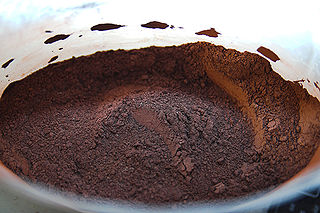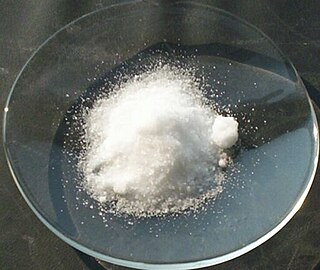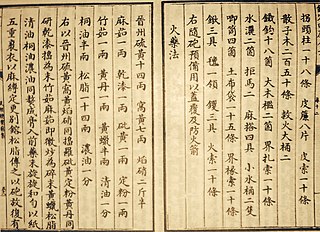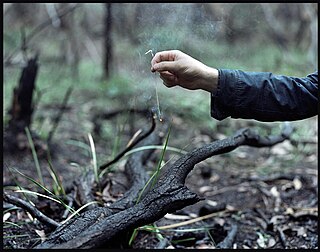Related Research Articles

Gunpowder, also commonly known as black powder to distinguish it from modern smokeless powder, is the earliest known chemical explosive. It consists of a mixture of sulfur, carbon and potassium nitrate (saltpeter). The sulfur and carbon act as fuels while the saltpeter is an oxidizer. Gunpowder has been widely used as a propellant in firearms, artillery, rocketry, and pyrotechnics, including use as a blasting agent for explosives in quarrying, mining, building pipelines and road building.

Thermite is a pyrotechnic composition of metal powder and metal oxide. When ignited by heat or chemical reaction, thermite undergoes an exothermic reduction-oxidation (redox) reaction. Most varieties are not explosive, but can create brief bursts of heat and high temperature in a small area. Its form of action is similar to that of other fuel-oxidizer mixtures, such as black powder.

Potassium nitrate is a chemical compound with a sharp, salty, bitter taste and the chemical formula KNO
3. It is an ionic salt of potassium ions K+ and nitrate ions NO3−, and is therefore an alkali metal nitrate. It occurs in nature as a mineral, niter (or nitre in the UK). It is a source of nitrogen, and nitrogen was named after niter. Potassium nitrate is one of several nitrogen-containing compounds collectively referred to as saltpeter (or saltpetre in the UK).

Corned beef, or salt beef in some Commonwealth countries, is salt-cured brisket of beef. The term comes from the treatment of the meat with large-grained rock salt, also called "corns" of salt. Sometimes, sugar and spices are added to corned beef recipes. Corned beef is featured as an ingredient in many cuisines.

Smokeless powder is a type of propellant used in firearms and artillery that produces less smoke and less fouling when fired compared to gunpowder. The combustion products are mainly gaseous, compared to around 55% solid products for black powder. In addition, smokeless powder does not leave the thick, heavy fouling of hygroscopic material associated with black powder that causes rusting of the barrel.
Green mix is an early step in the manufacturing of black powder for explosives. It is a rough mixture of potassium nitrate, charcoal and sulfur in the correct proportions (75:15:10) for black powder, but is not milled, pressed or corned. It burns much more slowly than black powder, when it chooses to burn at all, can still explode if ignited in a confined place; the deflagration is usually characterized by short, uneven sizzling followed by relatively long periods of smoulder.

Flash powder is a pyrotechnic composition, a mixture of oxidizer and metallic fuel, which burns quickly and produces a loud noise regardless of confinement. It is widely used in theatrical pyrotechnics and fireworks and was once used for flashes in photography.
Armstrong's mixture is a highly shock and friction sensitive primary explosive. Formulations vary, but one consists of 67% potassium chlorate, 27% red phosphorus, 3% sulfur, and 3% calcium carbonate. It is named for Sir William Armstrong, who invented it sometime prior to 1872 for use in explosive shells.
A pyrotechnic colorant is a chemical compound which causes a flame to burn with a particular color. These are used to create the colors in pyrotechnic compositions like fireworks and colored fires. The color-producing species are usually created from other chemicals during the reaction. Metal salts are commonly used; elemental metals are used rarely.
Rocket Candy, or R-Candy, is a type of rocket propellant for model rockets made with sugar as a fuel, and containing an oxidizer. The propellant can be divided into three groups of components: the fuel, the oxidizer, and the additive(s). In the past, sucrose was most commonly used as fuel. Modern formulations most commonly use sorbitol for its ease of production. The most common oxidizer is potassium nitrate (KNO3). Potassium nitrate is most commonly found in tree stump remover. Additives can be many different substances, and either act as catalysts or enhance the aesthetics of the liftoff or flight. A traditional sugar propellant formulation is typically prepared in a 65:35 (13:7) oxidizer to fuel ratio.
Brown powder or prismatic powder, sometimes referred as "cocoa powder" due to its color, was a propellant used in large artillery and ship's guns from the 1870s to the 1890s. While similar to black powder, it was chemically formulated and formed hydraulically into a specific grain shape to provide a slower burn rates with neutral or progressive burning, as opposed to the faster and regressive burn typical of randomly shaped grains of black powder produced by crushing and screening powder formed into sheets in a press box, as was typical for cannon powder previously.
A pyrotechnic composition is a substance or mixture of substances designed to produce an effect by heat, light, sound, gas/smoke or a combination of these, as a result of non-detonative self-sustaining exothermic chemical reactions. Pyrotechnic substances do not rely on oxygen from external sources to sustain the reaction.
Magnalium is an aluminium alloy with 5% magnesium and 95% aluminum.

A black powder substitute is a replacement for black powder used in muzzleloading and cartridge firearms. Black powder substitutes offer a number of advantages over black powder, primarily including reduced sensitivity as an explosive and increased efficiency as a propellant powder.

The Wujing Zongyao, sometimes rendered in English as the Complete Essentials for the Military Classics, is a Chinese military compendium written from around 1040 to 1044.

A powder mill was a mill where gunpowder is made from sulfur, saltpeter and charcoal.

Charcoal is a lightweight black carbon residue produced by strongly heating wood in minimal oxygen to remove all water and volatile constituents. In the traditional version of this pyrolysis process, called charcoal burning, often by forming a charcoal kiln, the heat is supplied by burning part of the starting material itself, with a limited supply of oxygen. The material can also be heated in a closed retort. Modern "charcoal" briquettes used for outdoor cooking may contain many other additives, e.g. coal.

Senko hanabi is a traditional Japanese firework. Essays about them date back to at least 1927.

A spark is an incandescent particle. Sparks may be produced by pyrotechnics, by metalworking or as a by-product of fires, especially when burning wood.
A black powder rocket motor propels a model rocket using black powder. Black powder rocket propellants consist of charcoal, sulfur, and potassium nitrate. Adjustments can be made to the amount of each component to change the rate at which the black powder burns.
References
- ↑ Toby Bridges (1 January 1972). Black powder gun digest. Digest Books. ISBN 978-0-695-80360-5.
- ↑ K.L. Kosanke; Barry T. Sturman; Robert M. Winokur; B.J. Kosanke (October 2012). Encyclopedic Dictionary of Pyrotechnics: (and Related Subjects). Journal of Pyrotechnics. pp. 996–. ISBN 978-1-889526-21-8.